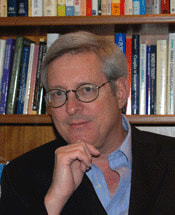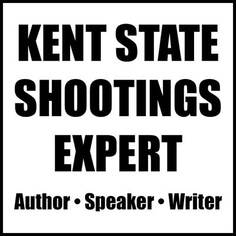|
After I wrote the article about Stuart Allen, saying he detected a second and actual order to fire (which no newspaper in the country, including the Daily Kent Stater, covered) I heard from John Mangels, the Plain Dealer's science reporter. Mangels was the author of the three front-page stories that gave rise to the calls for a new investigation. That made him, as far as I am concerned, one of the unsung heroes of May 4. He reminded me that he interviewed Captain Ron Snyder for his initial story on May 9, 2010, and that Snyder (like Captain Martin and Sergeant Matthew McManus) challenged Allen's finding, claiming the preliminary order did not sound like an order someone in the military would give.
That had completely slipped my mind, probably because Ron "Cynanide" Snyder is not a source I ever gave much credence to. That is partially because Snyder was not even among the squad that opened fire that day and thus, was not in a position to know what really happened. His unit was on the other side of Taylor Hall when the shootings broke, and the building completely blocked his view. Also, I still cannot get out of my head something said about Snyder after he originally told author James Michener, the Akron Beacon Journal, and a state grand jury that he confiscated a gun and brass knuckles off the body of slain student Jeffrey Miller. Snyder subsequently admitted he fabricated this claim because he wanted to make the victims seem dangerous, thereby making the shootings look justifiable. Snyder decided to come clean after the Justice Department started investigating this claim. I saw papers on Judge Frank Battisti's law clerk's desk suggesting the Justice Department seriously considered indicting him for perjury before the original state grand jury. I once had a beer with the editor who directed the ABJ's coverage, and he told me: "If he told me his name was Snyder, I still would not believe him." Snyder, incidentally, once guest lectured to my class in criminal justice at Kent in the spring of 1973. In a case of bad timing, I only found out about it afterwards. I had played hooky that day . . . Another interesting but not exactly earthshattering item: A few weeks ago I received a letter from the Justice Department's Freedom of Information office in response to an appeal I made for any records showing that the Justice Department did anything when they were asked to reinvestigate the new evidence. The Department's appeals division ignored part of my request and claimed they had no records of any such requests for reinvestigation, even though Justice Department officials met with a wounded survivor, other former students, and their attorney in May 2010. The Department's position--that there never were any calls for reinvestigation, and that no records ever were kept of this meeting, sounded highly suspicious to me. If the Department was telling the truth, that meant that all the public calls for a new investigation were made for publicity purposes, not to get the investigation. The wounded survivor I mentioned used to repeatedly get headlines by calling for additional investigations. Should not have he have made a formal request in writing? And did he and the others already understand that the only statute that still could be used to prosecute the Guardsmen--homicide--is a state, not a federal crime? The truth is there was not anything the Justice Department could have done anyway, save perhaps ask the National Academy of Sciences to review the tape and provide a second opinion . . . Finally, I recently received an e-mail out of the blue from a former Colorado National Guardsmen. He sharhed that that, after watching a film about riot control just before the campuses blew up in May 1970, "we all agreed that, if faced with a riot, we would set our M-16s on rock & roll (full automatic) and mow the protestors down." This dovetailed very closely with a story that a then Kent State student, told the FBI a year after the tragedy. The student claimed he hitched a ride from someone who told him he was one of the soldiers that fired at the students and that the troops had discussed shooting students before it actually happened. Unfortunately, the hitchhiker was only able to provide the FBI with very sketchy information about the soldier and his car. The FBI never was able to identify him, and that line of inquiry was never pursued by the attorneys who filed wrongful death claims against the Guardsmen. The letter at least reminded me of the mindset of many of those upholding the law--as well as many in the general public--in May 1970. The war and Kent State divided the country more deeply than any other time since the Civil War. As Time magazine reported even a year before the shootings , there was a sentiment throughout the country that when it came to the antiwar demonstrations, "enough is enough."
1 Comment
One of the things that surprised me about last year's Cleveland Plain Dealer exposes is that not a single Guardsman reacted to the news of Stuart Allen's findings. Over the weekend I came to understand why: some of them were unaware of his conclusions, and had nothing to react to.
I finally managed to get the first two interviews any journalist has had with former Ohio National Guardsman who were on Blanket Hill since Allen's conclusions were made public. The first, that is, since the Plain Dealer reported that Allen and another audio forensic specialist, Tom Owens, concluded there was a preliminary "prepare to fire" order to fire at Kent State (and Allen said there was an actual follow-up order). Last weekend I spoke with both John E. Martin, the captain of Company A, the 145th Infantry; and one of his sergeants, Matthew McManus. McManus was one of the eight Guardsmen who were indicted by the Justice Department; in his case, he fired a shotgun into the air that may or may not have caused a student's wounds. (A second Guardsman, Leon Smith, was also charged with shooting the same student.). The case against McManus was always considered to be the weakest of the eight, and a federal judge later acquitted him and his fellow indictees of depriving the victims of due process of law. Neither Martin nor McManus were familiar with the new findings and Martin stuck to the story he told all along: that he never gave nor heard any order to fire. McManus claimed the only order he ever heard was the one he admitted issuing long ago. After the firing had already started, McManus gave an order: “Fire over their heads” (the Justice Department’s version, or, as he tells it, “If you have to fire, for Christ’s sake, fire over their heads.”) McManus also insisted that the order audio experts Stuart Allen and Tom Owens detected on the tape—“Prepare to fire,” was not an order that anyone in the military would give. After 40 years, he could not remember how a verbal order to fire should have been phrased, but he insisted “prepare to fire” was something one would only hear at a military funeral. In fact, McManus suggested that the words might have been uttered not by a Guardsman, but by a student protestor affiliated with the radical Students for a Democratic Society (SDS). This defense had been used once at the 1975 wrongful death and injury trial, when the Guards’ attorneys tried to pin the entire blame for the shooting on the students themselves. At one point the lawyers suggested that Charles Deegan, an ex-Marine who served in Vietnam and subsequently returned to Kent as a student, had heckled the Guard by shouting cadence and issuing fake orders for the troops to follow. Deegan denied the claim, which I always thought was ludicrous and an act of desperation on the attorneys' part. The claim also reminded me of something else said to me by another of the Guards’ attorneys: “Let’s face it. We’re paid hatchet men.” Significantly, neither Martin nor McManus noticed Terry Norman on Blanket Hill. Martin said that several of his men heard a single shot prior to the main volley. McManus told me that just before shooting, he was on the far left of the Guard’s V-shaped formation (and on their far right after they turned around and fired). Before the shootings the only incident of note that he was aware of was between Major Harry Jones and a student who emerged from the crowd, threatening to throw a part of a torn-off tree branch at Jones and his communications officer. McManus said that Jones drew his pistol and told the student to stop. The shooting started shortly after that, and McManus said that that both he and Jones were “mad at the troops for firing.” McManus because, from his position, he could not see a reason to fire (although he was quick to defend his men by adding he could not see everything going on). He was also angry because he was in the line of fire and saw dirt kicking up within a few feet from where he was standing. (I had never heard that story before.) Jones, he said, was so mad he immediately and forcefully pushed the firing soldiers’ rifles in an upward position. We had known that for years. In fact, a private in McManus’ unit, Jeffrey Jones, told me years earlier that the first thing Jones demanded to know was: “Who gave you men the order to fire?” As an sidenote, McManus added that on the afternoon of May 3, the day before the shootings, he, another Guardsmen, and some students played euchre and touch football on the practice football field by Taylor Hall. McManus also felt “there is never going to be an end to” May 4 and alluded to "all the grief it brought to me,” including family turmoil he did not want to talk about. McManus clearly was not close enough to see what was happening on the other side of the Guards' V-shaped formation, where Troop G of the 107th Armored Cavalry did most of the firing. If nothing else, the captain and the sergeant provided us a preview of what the National Guardsmen's defense strategy would have been had any official investigation had gone forward. |
AuthorThis blog is written by William A. Gordon, a Kent State alumnus and the author of "Four Dead in Ohio" and three other books. It offers commentary on the still unfolding developments in the Kent State shooting case. Archives
March 2020
Categories
All
|
|
Kent State Shooting Expert
William A. Gordon Email: [email protected] Website: www.KentStateShootingsExpert.com |

 RSS Feed
RSS Feed
